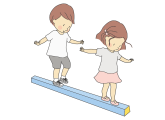There are different reasons why a child may not speak to practitioners or peers, including selective mutism, explains Michael Jones…
Three-and-a-half-year-old Magda has been attending preschool for six months, but the adults have yet to hear her speak to them in the setting.
She is just beginning to whisper to a few other children when playing outdoors, but clams up if she thinks an adult is watching or might be about to approach her.
Magda has started to play alongside other children in the role-play area but is often to be seen silently watching them from a distance.
Magda talks loudly to her mother as soon as she is round the corner from the setting and because of this the adults have stopped describing her as shy, and now use words like stubborn, and even manipulative and controlling.
Some staff are discussing whether or not Magda is an elective mute, and have started to use this phrase when talking about her.
It is quite understandable that the adults, when faced with a child like Magda, should be very concerned because she is not talking – particularly when they know that she is a confident talker elsewhere.
However, none of their assumptions are accurate.
So how can we support everyone to understand Magda’s behaviour and help her become a confident talker?
The most important thing we can do for children who are very quiet is to find out how they feel.
Many children are quiet when they first leave their parents to attend a group, but most soon find their confidence and become talkative with adults and then with other children.
However, many very quiet children are uncertain about what to do, how to behave and how to talk to other people.
They are particularly uncertain about how to talk with adults and other children when they are away from their parents.
Initially they may be more aware than other children about high noise levels, how fast some children move around, and are confused by having so many activities to choose from.
This can make them feel overwhelmed.
One of their biggest uncertainties is about how to use talk to gain an adult’s attention, and keep the adult focused on them when more confident children want to talk as well.
Using the term ‘elective mute’ implies that a child is choosing to be silent.
Children do not choose to be silent, but their response is invariably an automatic reaction to a situation that makes them feel very uncomfortable.
Nowadays the term ‘selective mutism’ is used to describe children who have developed a dread of speaking when away from their family.
The children feel physically unable to talk in certain situations, even though they are confident takers at home with familiar adults.
Children with selective mutism are extremely worried that they will be made to speak in front of other people.
Their fear is so great that they find themselves avoiding speaking, and in some cases become so frozen with fear that they are unable to move.
This extreme anxiety condition is relatively uncommon, though you’re likely to meet at least one child in your professional career who has been diagnosed as having selective mutism.
Many quiet children are shy. Shy children feel very uncomfortable in new situations, with unfamiliar adults and children, or when asked to take part in new activities when other people are watching them.
However, they become able to join in and talk if they are given the chance to practise new activities, and once they get to know and trust adults and other children.
Shy children are more concerned than confident children about making ‘mistakes’. They have a particular worry that adults and other children may think negatively about what they might do or say.
Shy children do not actively choose to opt out of activities where they feel uncomfortable, but are overwhelmed by feelings of anxiety and embarrassment.
This can include blushing, sweating, wanting to cry and having an urge to run away or hide.
Most of us have these feelings at one time or another so it’s easy to be sympathetic towards shy children.
The difficulty for children with selective mutism, on the other hand, is that they have learned to internalise their feelings and may develop a fixed smile, which gives adults the impression that they are happy and are just refusing to join in.
We can differentiate between shy children and those with selective mutism by the way that they react over time.
With sensitive support and encouragement, shy children become more confident about joining in and talking.
Those with selective mutism do not make this spontaneous progress and are likely to need support from an outside professional such as a speech and language therapist. They can work to help family, staff and the child work together on a specific programme.
Children who are learning an additional language often go through a silent period when first learning a language.
This is an active phase, when children are listening out for important information such as when one word ends and another one begins, and for familiar words that help them make sense of what is being said.
Most children emerge from this phase as chatty and confident speakers of their new language.
Magda was in fact shy and learning to speak English. Because she was worried about
making mistakes, and was unsure about how to get involved in play with other children, she was missing out on practising talking.
This made her feel more anxious.
However, she benefited from the strategies and support outlined below.
● Talk positively about the child. Instead of saying, “That’s our elective mute”, agree with all staff to say, “This is Magda. We know she talks confidently at home, and we are helping her find her confidence here.”
● Plan to repeat favourite activities, because quiet children benefit from repeating activities until they feel confident that they can do them.
● Assign a key person to spend time with the child, eg sharing books and playing in the role-play area.
● Encourage the child to play and talk with other children by helping them to do activities in pairs – eg completing a puzzle or giving out the cups at snacktime.
● Avoid making children answer their name at registration. Self-registration, where children take a name card and put it on a display at the beginning of the session, is more beneficial for all children.
● Provide reassurance when they engage with ‘risky’ activities like climbing and jumping; some quiet children have a particular worry about these and so benefit from adult support.
● Make sure the child’s key person shares their concerns with the child’s parents, but also explains what steps staff plan to take to help the child.
● Help the child make choices by allowing them and a parent to come into the setting ten minutes before the other children, so you can talk about what activities are available and talk with staff about what they might like to do during the session.
● Visit the child at home to find out about their special interests. If the family have a cat, for example, the child may enjoy bringing in a photo of their pet to show the adults and children.
If children are not making progress, or you suspect that a child has selective mutism, ask his or her parents’ permission to seek advice from specialists in this field.
Only speech and language therapists, psychologists or doctors with experience of selective mutism can make a diagnosis of this condition.
Finally, like all children, quiet children benefit most from being helped to join in happily with activities, without being put under pressure to speak.
This is often enough to set them on the right road to becoming confident talkers while away from home.
Michael Jones worked for over 30 years as a speech and language therapist, teacher, advisory teacher, and trainer, and now concentrates mainly on writing about young children’s language and learning. His book, Supporting Quiet Children, is co-authored by Maggie Johnson.

Early Years development – How to support children
Editors picks

Oral language – Laying the foundations in early years
Editors picks
